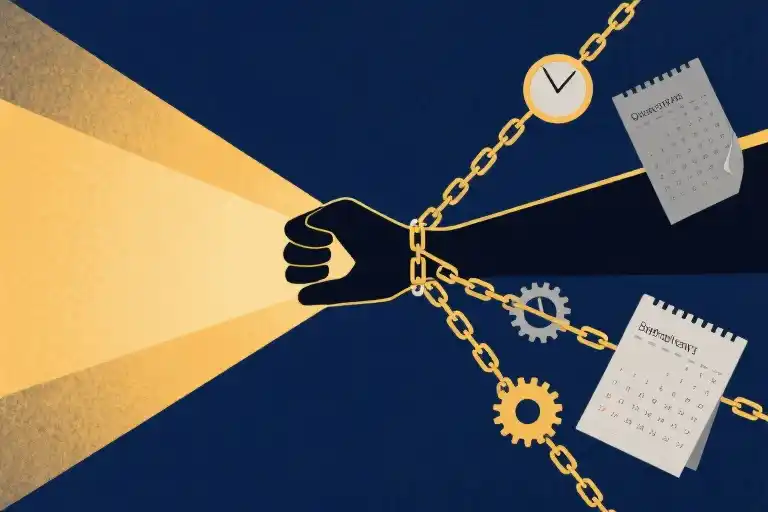The clock strikes 2 AM. Your laptop screen glows in the dark as you frantically type the last sentences of a report due in 6 hours. Your third coffee sits cold beside a phone that just logged 4.7 hours of social media use today. You knew this deadline was coming for weeks, yet here you are – exhausted, anxious, and secretly ashamed of this predictable last-minute scramble.
This isn’t just about poor time management. Procrastination costs the average professional 5.2 productive hours weekly (Journal of Behavioral Medicine, 2022), but the real damage lies deeper. That gnawing guilt when avoiding important tasks? It triggers a 23% spike in cortisol levels (American Psychological Association), making future productivity even harder. The vicious cycle continues: brief relief from delaying the task → mounting anxiety → further avoidance → diminished self-trust.
What makes this phenomenon so perplexing isn’t our awareness of its harm – 94% of chronic procrastinators acknowledge its negative impact (University of Calgary study). The real question haunting high-achievers isn’t “How do I manage time?” but “Why does my rational self keep losing to procrastination?”
Neuroscience reveals this isn’t a moral failing but a wiring issue. When facing daunting tasks, our limbic system (the brain’s “panic button”) overrides the prefrontal cortex (rational planner). The amygdala screams “Potential threat!” whether you’re staring at a blank document or a treadmill. Meanwhile, dopamine rewards us for quick wins like clearing notifications, creating an addiction to trivial tasks.
Three hidden fears often masquerade as procrastination:
- Failure avoidance: “If I don’t try fully, I can blame time pressure rather than ability”
- Success anxiety: “Completing this might raise expectations I can’t sustain”
- Control rebellion: “Self-sabotage feels like autonomy when overwhelmed”
The cruel irony? Avoiding that important task consumes 3x more mental energy than doing it (Journal of Experimental Psychology). You’re essentially paying compound interest on an emotional debt. But here’s the hopeful truth: productivity isn’t about motivation – it’s about designing systems that make action inevitable.
Tomorrow morning, millions will vow to “stop procrastinating” through sheer willpower. By afternoon, most will relapse. The solution lies not in grand resolutions but in understanding these four pillars:
- Task design: Breaking monolithic projects into “brain-friendly” steps
- Environment engineering: Removing friction from good choices
- Emotional recalibration: Separating feelings from actions
- Progress tracking: Making small wins visible
Before we explore practical strategies, pause and observe: What specific task have you been avoiding this week? Not a vague “work stuff” but one concrete item that reappears on your to-do list. That’s your personal testing ground for the tools we’ll uncover.
How Procrastination Hijacks Your Brain
We’ve all been there – staring at a blank document that should contain the first draft of your quarterly report, yet somehow finding yourself deep in a YouTube rabbit hole about urban beekeeping. That momentary relief from avoiding the task feels good… until the crushing guilt sets in.
The Neuroscience of Instant Gratification
Our brains are wired to prioritize immediate rewards over long-term benefits, a phenomenon neuroscientists call “temporal discounting.” When faced with an unpleasant task:
- The limbic system (our primitive pleasure center) screams for quick dopamine hits from easy distractions
- The prefrontal cortex (responsible for rational planning) gets overpowered like a librarian trying to quiet a rowdy classroom
This explains why scrolling social media often wins over starting that important project – your brain literally processes them as different types of decisions. The former provides certain instant pleasure, while the latter represents uncertain future payoff.
The Three Hidden Fears Behind Delay
Beneath surface-level laziness, procrastination often masks deeper psychological barriers:
- Fear of failure (“What if my work isn’t good enough?”)
- Fear of success (“Can I handle the expectations that come with doing well?”)
- Fear of losing autonomy (“This deadline is controlling me – I’ll rebel by delaying”)
These subconscious concerns trigger what psychologists call the “avoidance-approach conflict,” where we simultaneously want to complete the task (approach) but also escape its associated discomfort (avoidance). The result? Paralysis.
The Vicious Cycle of Temporary Relief
Here’s how procrastination becomes self-reinforcing:
flowchart LR
A[Unpleasant Task] --> B{Discomfort}
B -->|Delay| C[Temporary Relief]
C --> D[Increased Anxiety]
D --> AEach delay provides short-term emotional relief (“I’ll do it later”), but actually:
- Triples the mental energy spent worrying (University of Calgary research shows procrastinators spend 3x more time thinking about tasks than actually doing them)
- Creates false time pressure that reduces work quality
- Trains your brain to repeat the pattern through negative reinforcement
What makes this particularly insidious is that unlike other bad habits (say, smoking), the costs of procrastination are invisible until they accumulate into missed opportunities, damaged reputations, or all-nighters.
Breaking the Neural Patterns
The good news? Neuroplasticity means we can rewire these automatic responses. In the next section, we’ll explore how to:
- Outsmart your limbic system with “cognitive jiu-jitsu”
- Reframe task emotions to reduce avoidance triggers
- Build new neural pathways that make action your default mode
For now, try this quick awareness exercise: Next time you catch yourself reaching for distractions, pause and ask – am I avoiding discomfort right now? What exactly am I afraid might happen if I start? Just naming these feelings begins weakening their power.
5 Science-Backed Strategies to Overcome Procrastination
The 2-Minute Rule: Trick Your Brain Into Starting
We’ve all been there – staring at a blank document, mentally calculating how many coffee breaks we can take before actually writing that report. The 2-minute rule is your secret weapon against this paralysis. Here’s how it works:
- Break it down: Take any daunting task and reduce it to a 2-minute version
- Writing a business plan → Open document and type three bullet points
- Cleaning the garage → Put away just five items
- Exercising → Put on workout clothes and do two pushups
- Build momentum: Once you start, you’ll often continue beyond the initial 2 minutes
- Celebrate small wins: Completing micro-tasks builds confidence and motivation
Real-world example: Sarah, a marketing manager, transformed “create quarterly campaign” into “brainstorm 3 headline ideas for 2 minutes.” Those 2 minutes turned into 30 minutes of productive work.
Time Blocking: Create a Distraction-Free Zone
Our brains aren’t wired for multitasking. Time blocking creates artificial deadlines that force focus:
Implementation steps:
- Choose a high-priority task
- Set a timer for 25-50 minutes (depending on attention span)
- Eliminate distractions:
- Use apps like Forest (grows virtual trees during focus sessions)
- Try Cold Turkey Blocker to restrict access to distracting websites
- Follow with a 5-10 minute break
Case study: Graphic designer Mark used this method to complete a logo project by blocking three 25-minute sessions with 5-minute breaks. He reported finishing in half his usual time.
The Commitment Contract
Sometimes we need external accountability. Commitment contracts use loss aversion (our fear of losing something) to motivate action:
How to set it up:
- Identify what you’ll lose if you don’t complete the task (money, pride, etc.)
- Choose an accountability partner or use platforms like StickK
- Set clear terms (e.g., “If I don’t finish the presentation by Friday, I donate $100 to a cause I dislike”)
Pro tip: The more personally painful the consequence, the more effective this strategy becomes.
The Eisenhower Matrix
Not all tasks deserve equal attention. This prioritization method helps distinguish between:
- Urgent & important (do now)
- Not urgent but important (schedule)
- Urgent but not important (delegate)
- Neither (eliminate)
Practical application:
- Create a 2×2 grid each morning
- Assign all tasks to one quadrant
- Tackle quadrant 1 items first
The 5-Second Rule
When hesitation strikes, count backward from 5 and take immediate physical action. This interrupts procrastination patterns by:
- Short-circuiting the “overthinking” brain
- Creating automatic behavior before doubt sets in
- Building a habit of decisive action
Example: When you think “I should start my taxes,” immediately count “5-4-3-2-1” and open your tax documents before your brain can protest.
Making It Stick
These strategies work best when:
- Track progress: Use a simple checklist or app like Habitica
- Expect setbacks: The first three days are hardest – push through
- Pair with rewards: Celebrate completing focus sessions
Remember: Overcoming procrastination isn’t about perfection. It’s about consistently choosing action over avoidance, one small step at a time.
Tailored Strategies to Beat Procrastination in Every Area of Life
We’ve all been there – staring at a looming work project while compulsively refreshing social media, promising to study ‘after one more episode,’ or watching dishes pile up while telling ourselves ‘I’ll do it later.’ The truth is, procrastination manifests differently across various aspects of our lives, requiring customized solutions. Here’s how to apply science-backed strategies to three common procrastination battlegrounds.
The Workplace: Taming Complex Projects
For knowledge workers facing intimidating deliverables, the ‘1+3’ task system creates psychological safety through structure:
- Identify your ‘1’ – Each morning, select one meaningful task that would make your day successful if completed
- Define three micro-steps – Break it into the smallest possible actions (e.g., ‘Quarterly report’ becomes: ① Open template ② Paste last quarter’s data ③ Write two analysis bullet points)
- Schedule focus blocks – Use time blocking to assign specific 25-minute windows (research shows this optimal for sustained concentration)
Real application: Sarah, a marketing manager, used this method to complete a campaign strategy that had been delayed for weeks. Her ‘1’ was ‘finalize Q3 campaign framework,’ with micro-steps including ‘reread brief’ and ‘list three theme ideas.’ The granularity eliminated the paralysis of starting.
Academic Success: Overcoming Study Avoidance
Students battling textbook resistance can leverage social accountability through these steps:
- Create a commitment contract – Use platforms like StickK to pledge money (donated to an ‘anti-charity’ if you fail) or public shame (‘I’ll post my procrastination log on Instagram’)
- Design a study environment – Implement the ‘nuclear option’ for distractions: ① Uninstall entertainment apps during finals ② Use website blockers ③ Study in designated locations only
- Employ the Pomodoro technique – 25 minutes of focused study → 5-minute movement break (this rhythm aligns with natural attention cycles)
Case study: Pre-med student Jason improved his MCAT prep efficiency by 40% after creating a study contract where missed sessions meant donating to a political party he opposed. The emotional cost of breaking his commitment outweighed temporary laziness.
Domestic Productivity: Ending Household Task Avoidance
For chores that never seem urgent enough to prioritize, the ‘2-minute launch pad’ method works wonders:
- Immediate action triggers: Pair tasks with existing habits (e.g., ‘After pouring morning coffee, I’ll spend 120 seconds loading the dishwasher’)
- Visual progress tracking: Use a simple whiteboard to check off completed micro-tasks (the dopamine hit encourages continuation)
- The ‘just one’ principle: Commit to doing just one item from a dreaded category (once started, momentum often carries you further)
Pro tip: Research from the American Psychological Association shows that task initiation (not completion) is the primary psychological barrier. By focusing solely on starting – not finishing – dishes, laundry, or other chores, you’ll often find yourself completing them effortlessly.
Cross-Cutting Principles for All Scenarios
- The 5-Second Rule: When you notice procrastination impulses, count down 5-4-3-2-1 and physically move toward your task (this interrupts automatic avoidance patterns)
- Energy matching: Schedule demanding tasks during personal peak productivity windows (morning person? Tackle tough projects before noon)
- Progress journaling: End each day by noting three completed actions (reinforces positive behavior patterns)
Remember: Different procrastination contexts require different tools, but the core principle remains – make starting easier than avoiding. Which area will you tackle first with these strategies?
Breaking the Cycle: Your Roadmap to Lasting Change
We’ve all been there – that moment of clarity when you realize procrastination has stolen another day. But here’s the good news: understanding your patterns is the first step to rewriting them. Let’s build your personalized anti-procrastination toolkit that actually sticks.
The Power of a Procrastination Journal
Think of this as your habit detective notebook. When you feel that familiar urge to delay:
- Record the trigger (“3pm email notification about project deadline”)
- Note your emotional state (“Overwhelmed, underqualified”)
- Track what you did instead (“Scrolled LinkedIn for 40 minutes”)
Research shows people who track procrastination triggers reduce delay time by 37% within three weeks. Keep it simple – a notes app section or small notebook works perfectly.
Your 2-Minute Action Challenge
Right now, choose one tiny step from your to-do list that would take ≤120 seconds. Maybe it’s:
- Opening that report document
- Texting a colleague to schedule tomorrow’s meeting
- Putting your workout clothes by the bed
Complete it immediately after reading this sentence. Notice how crossing even this micro-task off your list creates momentum. This is the 2-minute rule in action – small wins build unstoppable productivity.
The Compound Effect of Habit Reshaping
Neurological studies reveal that consistent 21-day practice can rewire procrastination pathways in your brain. Picture each anti-delay action as depositing in your “productivity bank”:
| Day Range | Brain Changes | Real-World Impact |
|---|---|---|
| 1-7 | New neural pathways form | Tasks feel slightly less daunting |
| 8-14 | Myelin sheaths strengthen signals | Automatic task initiation begins |
| 15-21 | Basal ganglia encodes behaviors | Consistent action becomes default |
When Willpower Falters: The Backup Plan
Even with great systems, off days happen. Prepare your safety nets:
- The 10-minute reset: When stuck, set a timer for 600 seconds of focused work. Often, starting is the only hurdle.
- Accountability partners: Share your daily priority with someone who’ll check in gently.
- Environment redesign: Keep phone in another room during work blocks if digital distractions derail you.
Your Next Right Step
Before you close this article:
- Set a phone reminder titled “PROCRASTINATION TRIGGER CHECK” for tomorrow at your most vulnerable time (often mid-afternoon)
- Schedule three 2-minute task blocks in your calendar right now
- Celebrate completing this reading – you’ve already taken action toward change
Remember what behavioral scientist BJ Fogg teaches: “Emotions create habits.” Each small victory trains your brain to associate task completion with satisfaction rather than dread. The time you previously lost to procrastination? Consider it tuition for the productivity mastery you’re now building.





